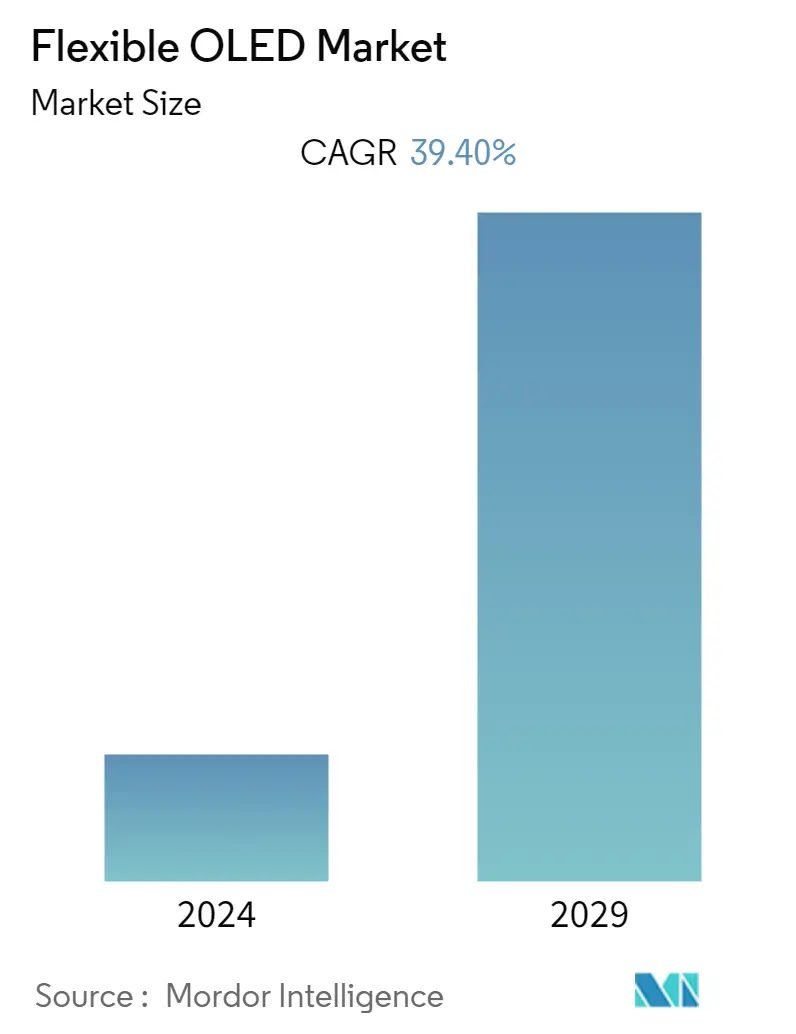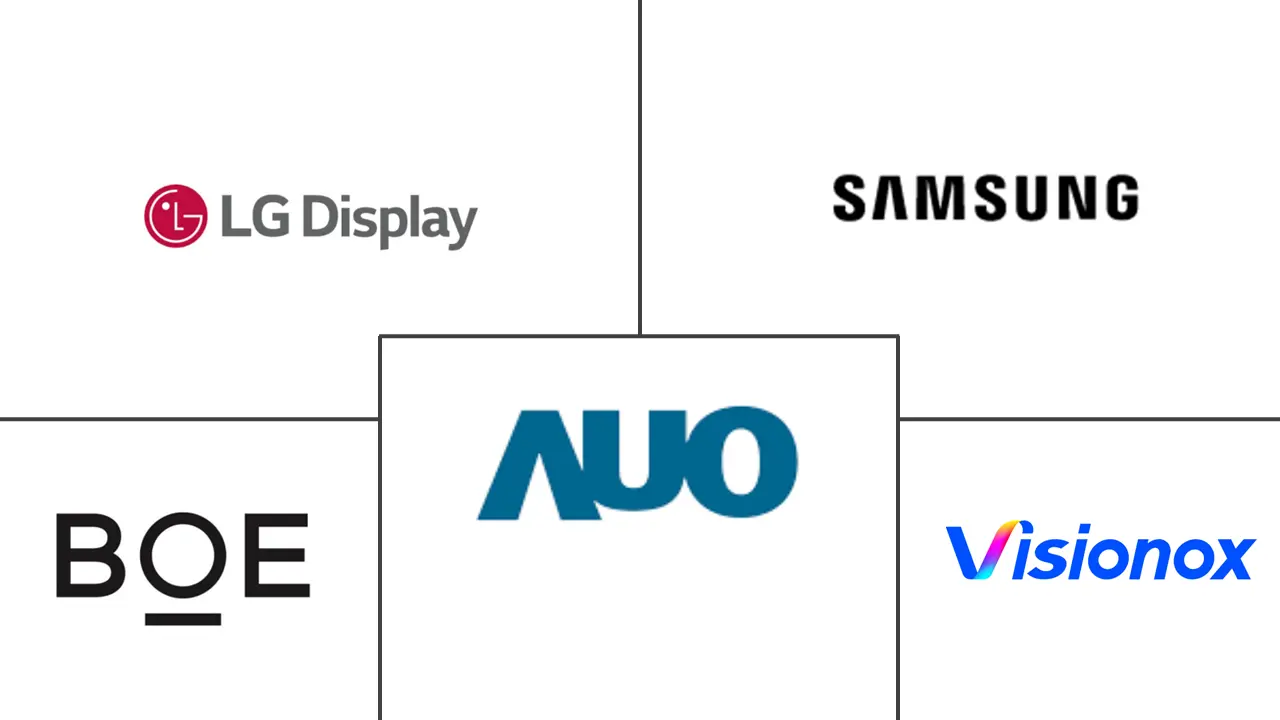Market Size of Flexible OLED Industry

| Study Period | 2019 - 2029 |
| Base Year For Estimation | 2023 |
| CAGR | 39.40 % |
| Fastest Growing Market | Asia Pacific |
| Largest Market | Asia Pacific |
| Market Concentration | Low |
Major Players
*Disclaimer: Major Players sorted in no particular order |
Flexible OLED Market Analysis
The Global Flexible OLED Market is expected to register a CAGR of 39.4% during the forecast period. OLED display technology, which provides beautiful and efficient lighting panels, is already being used in many mobile devices and TVs. Flexible OLED is the next-generation technology that enables opportunities for folding and curving these displays on applications.
- OLED is an emerging display technology that enables beautiful and efficient displays and lighting panels. OLEDs are already being used in many mobile devices and TVs, and the next generation of these panels will be flexible and bendable. OLEDs are the latest generation technology in the display industry and provide superior performance and enhanced optical characteristics compared to older LED and LCDs.
- The usage of flexible display technology in smartphones and tablets looks a bit unclear as with external factors such as user acceptability, protection and cost-effectiveness being some of the major challenges to be met by the smartphone companies, but it can find its wide usage in other industry such as automobiles and transportation.
- As of the recent developments Samsung Display plans to build a new 6-Gen flexible OLED line. The new line will replace a current LCD line that is used to produce TVs at SDC's Asan plant. The new fab, will cost around KRW 3 trillion or around USD 2.7 billion and will have a monthly capacity of 30,000 monthly substrates. This will increase Samsung Display AMOLED production capacity to 195,000 monthly substrates.
- Also, in November 2021, Samsung Displays, entered the medium-sized OLED market with the new high-refresh-rate displays for laptops. Samsung Display's flexible OLED screens can be folded, rolled, or slid. It feature high brightness, HDR10+ content playback, a low folding radius (R1.4), and better screen protection (UTG) compared to products from rival firms. The displays can be folded more than 200,000 times, equivalent to 100 folds and unfolds every day for five years.
- Further, the market is witnessing innovation. In January 2022, the customized 3D printing of a flexible organic light-emitting diode (OLED) display has been developed by a team from the University of Minnesota Twin Cities in the United States. The breakthrough, which is based on the conversion of electricity into light using an organic material layer, could lead to inexpensive OLED displays for handheld or wearable electronics made at home using 3D printers.
- COVID-19 has had a detrimental influence on the market as a result of several cities being shut down, causing damage to the supply chain for phone and display production, and reducing smartphone sales around the world. With more strict measures being imposed by governments throughout the world, the lockdown, which has brought economic activity to a halt, is projected to have a stronger impact in the near future. A lengthy lockdown has resulted in the temporary closure of factories, causing production and shipping of commodities to be hampered.
Flexible OLED Industry Segmentation
The Global Flexible OLED Market is segmented by Technology (AMOLED, PMOLED), by Application (Mobiles and Tablets, Monitors and TV's, Wearables), and by Geography. The flexible OLED technology provides high definition quality with a wide range of applications. The scope of the study for the flexible OLED market has considered both OLED technologies and the respective end-user application across regions in the world.
| By Technology | |
| AMOLED | |
| PMOLED |
| By Application | |
| Mobiles and Tablets | |
| Monitors and TVs | |
| Wearables | |
| Other Applications |
| By Geography | |
| North America | |
| Europe | |
| Asia-Pacific | |
| Latin America | |
| Middle East & Africa |
Flexible OLED Market Size Summary
The flexible OLED market is poised for significant growth, driven by advancements in display technology that allow for bendable and foldable screens. This next-generation technology is gaining traction in various sectors, particularly in mobile devices, automobiles, and transportation, despite challenges such as user acceptability and cost-effectiveness. Companies like Samsung Display and LG Display are at the forefront, investing heavily in new production lines and innovative products to enhance their market presence. The market is characterized by intense competition, with major players like LG Display, Samsung Electronics, and BOE Technology Group focusing on expanding their consumer base and introducing cutting-edge products. The growing demand for high-definition displays in smartphones and other devices is further propelling the market, as more companies adopt AMOLED technology in their flagship models.
The flexible OLED market is also witnessing rapid innovation, with developments such as 3D-printed OLED displays and new materials that enhance display performance and durability. The market's expansion is supported by increasing disposable incomes in regions like India and China, leading to a higher adoption of premium electronic products. Additionally, the market is benefiting from strategic partnerships and investments by key players, aiming to secure a competitive edge. The COVID-19 pandemic initially disrupted supply chains and production, but the market is recovering as companies adapt and innovate to meet the growing demand for flexible OLED technology.
Flexible OLED Market Size - Table of Contents
-
1. MARKET INSIGHTS
-
1.1 Market Overview
-
1.2 Industry Attractiveness - Porter's Five Forces Analysis
-
1.2.1 Bargaining Power of Suppliers
-
1.2.2 Bargaining Power of Consumers
-
1.2.3 Threat of New Entrants
-
1.2.4 Threat of Substitutes
-
1.2.5 Intensity of Competitive Rivalry
-
-
1.3 Impact of COVID-19 on the Flexible OLED Market
-
-
2. MARKET SEGMENTATION
-
2.1 By Technology
-
2.1.1 AMOLED
-
2.1.2 PMOLED
-
-
2.2 By Application
-
2.2.1 Mobiles and Tablets
-
2.2.2 Monitors and TVs
-
2.2.3 Wearables
-
2.2.4 Other Applications
-
-
2.3 By Geography
-
2.3.1 North America
-
2.3.2 Europe
-
2.3.3 Asia-Pacific
-
2.3.4 Latin America
-
2.3.5 Middle East & Africa
-
-
Flexible OLED Market Size FAQs
What is the current Flexible OLED Market size?
The Flexible OLED Market is projected to register a CAGR of 39.40% during the forecast period (2024-2029)
Who are the key players in Flexible OLED Market?
LG Display Co.,Ltd., Samsung Electronics Co. Ltd, BOE Technology UK Limited, AUO Corporation and Visionox Company are the major companies operating in the Flexible OLED Market.

